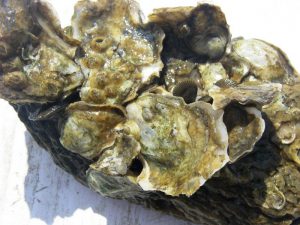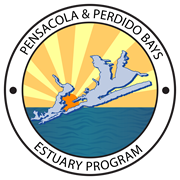
There are a number of projects that aim to enhance the oyster fishery and habitat within the Pensacola Bay System. Collectively, these projects will contribute to a productive and healthy ecosystem for future generations to enjoy.
Below is a list of projects currently in place within the Pensacola Bay system to enhance oyster habitat and the ecosystem services they provide. Learn more about oysters by watching this Gulf Sea Grant video series: “Oysters: Adapting to a changing Gulf.”
FL Department of Agriculture and Consumers Services 2016 planting:

The Florida Oyster Cultch Placement project, part of the Natural Resource Damage Assessment (NRDA) Phase III Deepwater Horizon early restoration began in Escambia and East Bays in 2016. The Florida Department of Agriculture and Consumer Sciences placed 20,103 cubic yards of a lime rock aggregate over an estimated 88 acres of oyster reefs in the Pensacola Bay System.
The project is managed and monitored by the Florida Department of Environmental Protection and the the Deepwater Horizon Office. The project will be monitored for 10 years. Read the results of the 2019 monitoring event here.

FDEP installed 866 intertidal reefs between Garcon and White points. Past monitoring showed that coverage of spat, juveniles and adult oysters varied greatly among the reefs (0-90% coverage per reef).

The Nature Conservancy: In 2015, the National Fish and Wildlife Foundation Gulf Environmental Benefit Fund (NFWF GEBF) funded The Nature Conservancy (TNC) to implement the Pensacola East Bay Oyster Habitat Restoration project. The primary objective of the project is to restore oyster habitat in the East and Blackwater Bays in Santa Rosa County. Oyster reefs and oyster fisheries, once very prevalent, have all but disappeared from the system. TNC has contracted with Jacobs for the design, permitting and construction oversight and with Ecology and Environment for the pre- and post-construction monitoring of the project, both with offices in Pensacola.
TNC anticipates reef construction to start in October 2020 following successful current negotiations with a construction firm. Once complete, there will be 33 individual oyster reefs of various sizes constructed along approximately 6.5 miles in East Bay, Santa Rosa County, followed by five years post-construction monitoring to assess the effectiveness of the reef structures.
The reef structures are designed to promote settlement and colonization of oyster larvae and provide secondary services, including serving as a larvae source to the nearby commercial oyster reefs restored with NRDA funding, as habitat for other organisms, and nursery and food source for commercially and recreationally important finfish and shellfish, and wading and shorebirds. For information contact Anne Birch, The Nature Conservancy, Florida Marine Program Manager, abirch@tnc.org.
The Greater Pensacola Bay System Oyster Stakeholder Ecosystem-Based Fisheries Management Plan

TNC has brought together 26 stakeholders to begin the development of the Oyster Ecosystem-Based Fisheries Management Plan. The goal of the plan is to ensure that the regulation and management of the oyster fishery, and oyster restoration policies are informed by the best available science and shared stakeholder stewardship values. The working group’s recommendations will be delivered in the form of a Greater Pensacola Bay System Oyster Ecosystem-Based Management Plan.
Santa Rosa County RESTORE:
Santa Rosa County Restore has funded the SRC Oyster shell recycling program and Pensacola, East and Blackwater Bays Intertidal and Subtidal Oyster Reef mapping and Assessment projects. The TNC has contracted to begin the mapping project this summer.
Oyster Mapping Project summary:

To map and assess the condition of known and potential intertidal and subtidal oyster reef resources in the Santa Rosa County portion of the Pensacola Bay system. Results of this mapping project will establish a baseline of the existing locations and condition of oyster resources in SRC. This information will help to guide future restoration projects in Santa Rosa County.

The Offer Your Shell to Enhance Restoration (O.Y.S.T.E.R) recycling pilot program kicked off the new year in Santa Rosa County. Participating restaurants, include the Cutting Board and Cossee’s in Milton and the Shrimp Basket (Milton and Navarre locations). Members of the Conservation Corps of the Emerald Coast (CCEC), part of Franklin’s Promise Coalition, are making the regular collections. More than 8000 lbs. of shell was collected in the six weeks before the program was impacted by the Covid-19 crisis. The program resumed in late May. We will continue to recruit a few more restaurants to participate in shell recycling.

Aquaculture: There are 4 aquaculture water column leases in SRC. Two businesses are currently growing oysters in cages in Escambia and East Bays. East Bay Oysters is the latest company to start a farm in East Bay in Santa Rosa county. Look for East Bay Oysters in late fall of 2020. In addition, East Bay Oysters will be offering farm tours at this time also!
All these projects will help to enhance our oyster fishery and valuable habitat. In addition, The US Environmental Protection Agency has established the Perdido/Pensacola Bay Estuary Program (PPBEP).  The mission of the PPBEP is to restore and protect the water quality and natural resources of the Pensacola & Perdido Bays and watersheds through partnerships, using a community-based, scientifically-sound approach to enhance resilience.
The mission of the PPBEP is to restore and protect the water quality and natural resources of the Pensacola & Perdido Bays and watersheds through partnerships, using a community-based, scientifically-sound approach to enhance resilience.
Below is the commercial landing data from 1995-2018. Looking at the graph below you can see natural and man-made impacts on the oyster fishery in the Pensacola Bay System.
From Fl. Fish and Wildlife Conservation Commission Commercial Fisheries Data

 0
0
